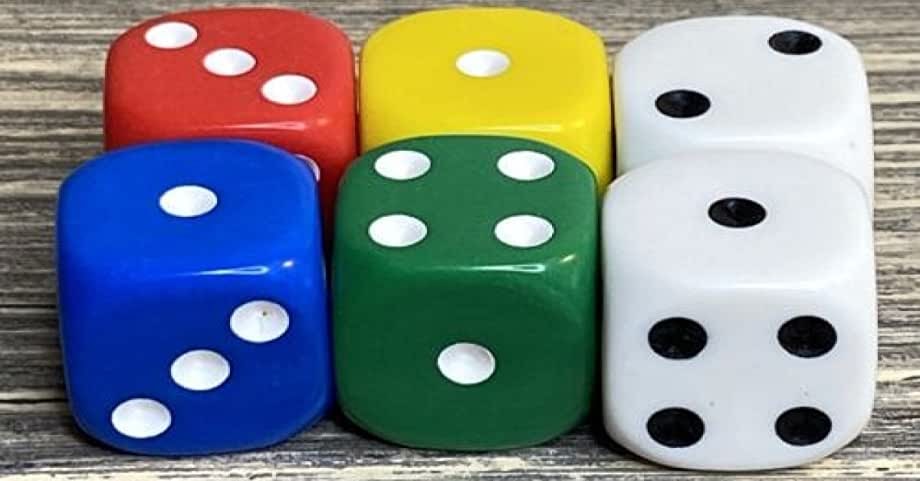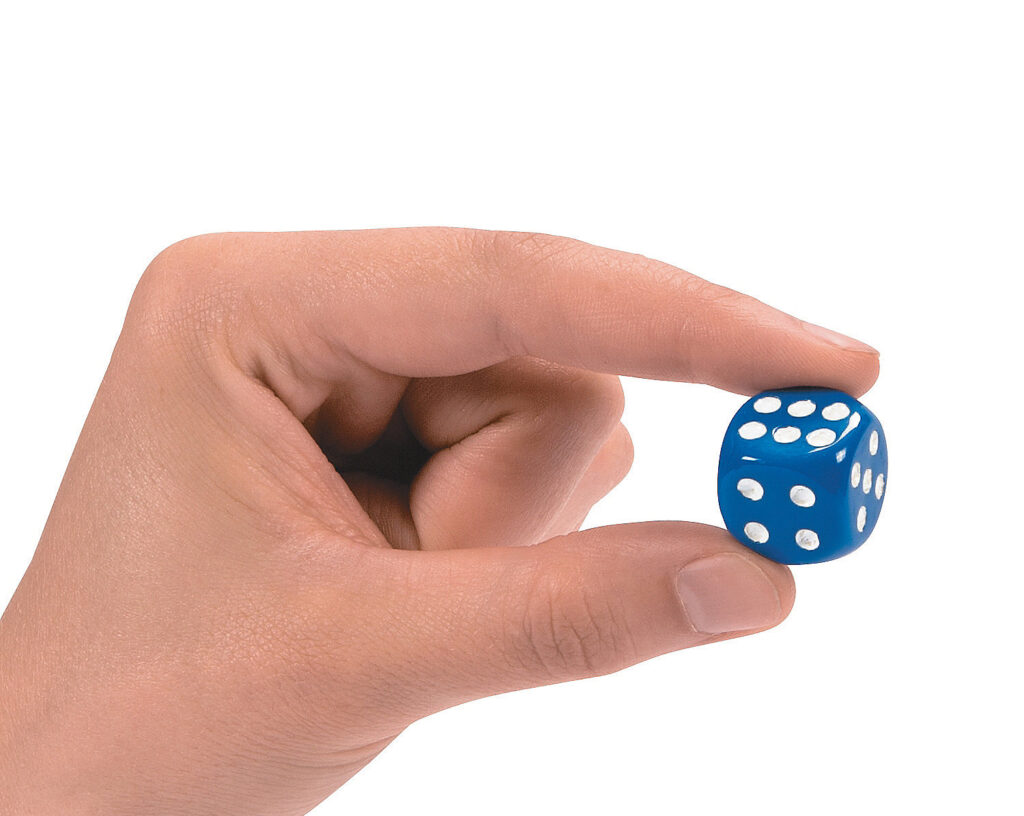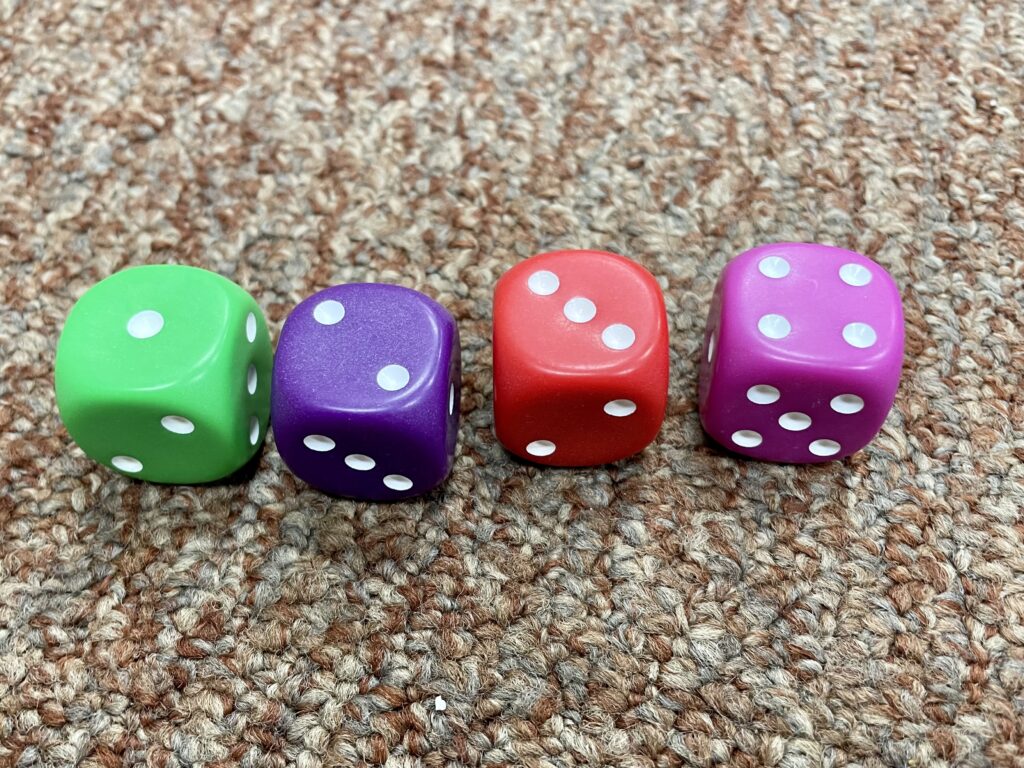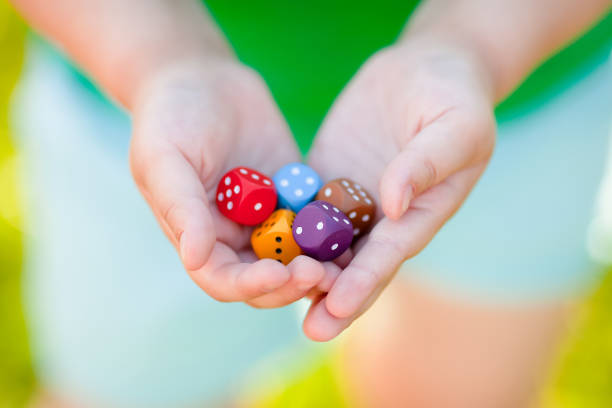Dice Are Nice!

A pair of four-year-olds in my classroom are happily playing “dice wars,” a simple but fast-paced game. To play, each child rolls a die and the player who rolls the highest number wins. No one is keeping score today—and nobody seems to care who wins each round.
I watch as Juan shakes the die between his palms, rolls it, counts each pip (dot) on the side that’s facing up and announces, “1, 2, 3!” I rolled a three!”
“My turn!” exclaims Maria as she shakes the die between her hands and rolls it. “SIX! I win! Six is more than three!” Maria doesn’t need to count the pips. She recognizes the pattern immediately and her number sense tells her the value of the pips on the die.
Rolling a die is fun in its own right, but these friends are working on the math skill known as subitizing. When children begin to recognize the pattern on the die and associate it with the number of pips (dots) without counting each pip, that is subitizing!

Children develop subitizing skills in much the same way that they learn to read sight words.
In a previous Early Math Counts blog post, Jen Asimow, M.Ed, explained it this way: “Remember when you learned about ‘sight words’ and how children learn them? According to one school of thought, children memorize sight words by taking a mental snapshot of the entire word. By using context clues, they learn the word as a ‘whole’ rather than as a series of letters. Consider how children learn the words EXIT or STOP. Both of these words appear in the same way—on signs above doors or on red octagonal street signs—and nearly always in the same colors and typefaces. All of these clues help children form a mental picture of these two words, and they often learn the pictures before they learn the individual letters that make up the words.”
Maria and Juan are playing with a die, so they are only working with numbers ranging from one to six. As they play successive rounds of the game, they are beginning to recognize the patterns on the die without counting the individual pips.
With every roll of the die, Juan’s pattern-recognition skills are growing stronger. Before long, he can recognize the total number of pips on each throw without counting.
According to child development experts, the ability to subitize quantities up to and including four by the age of five represents a significant developmental milestone.
Subitizing is a fundamental math skill, and dice games are a good way to help foster the development of this skill.

“Hey! Do you want to play that block-building dice game?” asks Pierre as he grabs a die from the jar and joins the group.
Roll and Build is another dice game that we’ve played in our classroom for years. One child rolls a die and the other children add that number of blocks to their towers. Children learn to recognize four dots on a die, which helps them understand the cardinal value (how many four represents), which they can then link to the symbol (4) and the word (four).

Games like this provide repeated opportunities to interpret the dot images. As children figure out how many pieces to collect or add or how many spaces to move on a game board, they develop their number sense and other early math skills such as counting, number identification, the correlation between numbers and the items being counted and concepts such as greater than or less than.
Keep a jar full of dice within easy reach to give the children plenty of opportunities to practice and make up their own games.
Begin by subitizing quantities of 1, 2 and 3. In a math workshop that I attended, the trainer had blacked out the pips representing 4, 5 and 6 for the younger children.
If a child is having difficulty subitizing, reduce the quantity of dots.

Dice games help young children develop math and social-emotional skills in a fun and engaging way. So grab some dice and introduce your gang to subitizing fun!
Check out our Early Math Counts lessons page for dice game ideas. Be sure to click on the Connect With Families button in the left-hand column of each lesson to download a Parent Letter that you can customize to share the day’s learning activity with parents and other family members.
Pattern recognition is so important and once you point them out to the children they will notice their own patterns.
This is an excellent way to incorporate math into the class the children love to play with small objects with teacher presents.
i love the idea of rolling the dice and adding blocks to construct something
I loved this idea also. I think I will implement it in my classrooms
My children are learning number patterns with the pips on the dice the pattern of one die can match another die even. odd
The use of dice is a fun way to practice and build math sense.
we use dice often, its easy to incorporate this into any activity they love when we subitize
Playing with dice uses and helps develop number sense skills.
The pips on the dice help recognize patterns.
dice are a great way to teach math
This is a great way to teach many math proccesses. They can see and touch the objects that represent their thinking.
Gayla Gaston
Dice are great to teach and have fun with math.
Great way to have fun learning, Im going to play this with my class!!
What a great way to learn number sense.
Great basic Game for simple … Data collection / Pictographs / Analysis
I use large dice and allow the children to toss them high in the air. I also use online dice generators where the children are able to hit the button and the dice roll. They are then instructed to write the combination(s) down to solve the equation.
Easiest and very fun way to get kids to subitize. And any number or number of groups can play.
These are great ideas. I love using dice in the classroom. They have so much fun rolling and counting them. We use the block activity too. They like to see who can make the tallest tower.
We have regular dice and also some larger foam dice – will try out these ideas next week!
The dice are helpful to teach data and analysis to children too! By having them keep track of the numbers they roll.